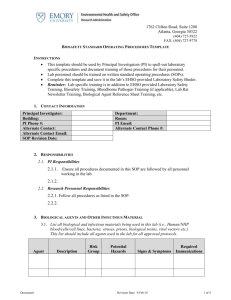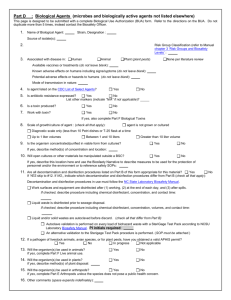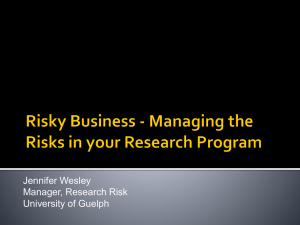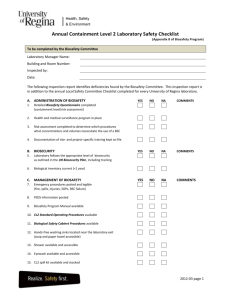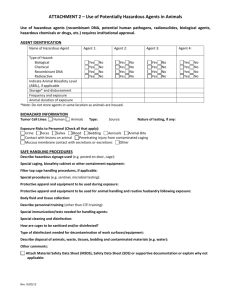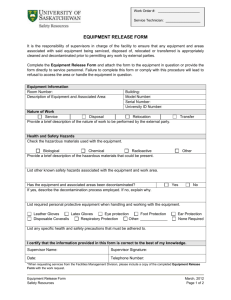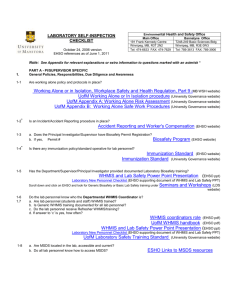Biosafety Permit Application
advertisement
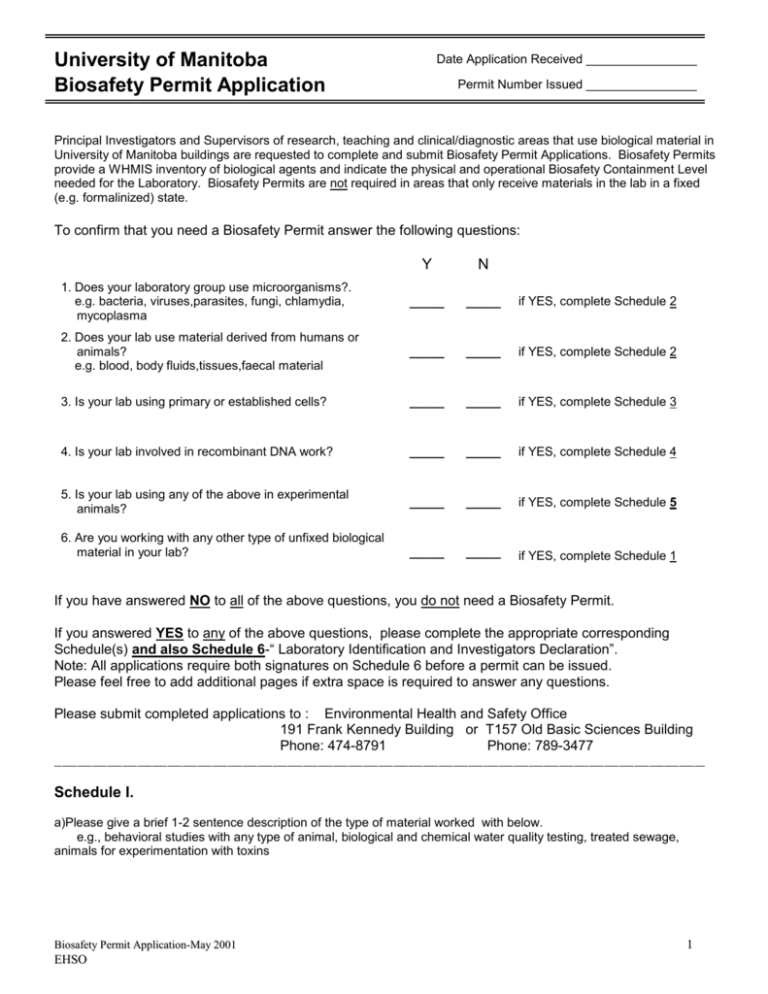
University of Manitoba Biosafety Permit Application Date Application Received ________________ Permit Number Issued ________________ Principal Investigators and Supervisors of research, teaching and clinical/diagnostic areas that use biological material in University of Manitoba buildings are requested to complete and submit Biosafety Permit Applications. Biosafety Permits provide a WHMIS inventory of biological agents and indicate the physical and operational Biosafety Containment Level needed for the Laboratory. Biosafety Permits are not required in areas that only receive materials in the lab in a fixed (e.g. formalinized) state. To confirm that you need a Biosafety Permit answer the following questions: Y N 1. Does your laboratory group use microorganisms?. e.g. bacteria, viruses,parasites, fungi, chlamydia, mycoplasma _____ _____ if YES, complete Schedule 2 2. Does your lab use material derived from humans or animals? e.g. blood, body fluids,tissues,faecal material _____ _____ if YES, complete Schedule 2 3. Is your lab using primary or established cells? _____ _____ if YES, complete Schedule 3 4. Is your lab involved in recombinant DNA work? _____ _____ if YES, complete Schedule 4 5. Is your lab using any of the above in experimental animals? _____ _____ if YES, complete Schedule 5 _____ _____ if YES, complete Schedule 1 6. Are you working with any other type of unfixed biological material in your lab? If you have answered NO to all of the above questions, you do not need a Biosafety Permit. If you answered YES to any of the above questions, please complete the appropriate corresponding Schedule(s) and also Schedule 6-“ Laboratory Identification and Investigators Declaration”. Note: All applications require both signatures on Schedule 6 before a permit can be issued. Please feel free to add additional pages if extra space is required to answer any questions. Please submit completed applications to : Environmental Health and Safety Office 191 Frank Kennedy Building or T157 Old Basic Sciences Building Phone: 474-8791 Phone: 789-3477 Schedule I. a)Please give a brief 1-2 sentence description of the type of material worked with below. e.g., behavioral studies with any type of animal, biological and chemical water quality testing, treated sewage, animals for experimentation with toxins Biosafety Permit Application-May 2001 EHSO 1 Schedule 2. Hazard Assessment and WHMIS Inventory for use of Biological Agents 1. List of Biological Agents Biological Agent -Include all microorganisms such as bacteria , viruses, mycoplasma, chlamydia, parasites etc. Target Host Range - Is this an actual or potential human, animal or plant pathogen? Please indicate (H)-human and/or (A)-animal and/or (P)-plant pathogen or (O)other. Route(s) of Transmission -(R)respiratory, (I)ingestion),(M)mucous, (IN)inoculation, if human or animal pathogen. Risk Group 1,2 or 3 –According to Health Canada’s “Laboratory Biosafety Guidelines”-see chapter 4. Reference -e.g. Health Canada’s MSDS, ATCC, Health Canada or journal reference listing risk group of organism. Biological Agent List Target Host Range Route(s) of Transmission Risk Group (1,2 or 3) Reference 1.1 1.2 1.3 1.4 1.5* *Please attach additional pages if necessary Individual clones need not be listed if they exhibit the same biohazardous characteristics 2. List of Human and Animal Blood, Body fluids and Tissues MATERIAL DERIVED FROM HUMANS OR ANIMALS, MUST BE CONSIDERED AS POTENTIAL BIOHAZARDS. - All work with human blood, tissues and fluids regardless of source, needs to be handled at a minimum with Universal Precautions which equates to Level 2 containment. All staff must be made aware of this. Protocols for treating accidental blood/body fluid splashes or needle stick injuries must be in place and posted. - Special consideration must be given to samples that may contain prions. Biological material which arrive at the lab in a fixed state (e.g. formalinized) need not be listed except for fixed neurological material which does need to be listed. - For animal work, zoonotic diseases must be considered. All Staff must be made aware of this and protocols for treating accidental inoculation and bites if appropriate must be in place and posted. - The inclusion of an immunization program should be considered. This can be discussed with the EHSO Occupational Health Coordinator (Phone 474-6438). Specimen Source e.g.clinical sample, normal donor pool, Red Cross, commercial animal breeding facility, Description of Tissue or Body Fluid Species of Origin Specimen Source Risk Group (1,2 or 3) Reference 2.1 2.2 2.3 2.4* *Please attach additional pages if necessary Biosafety Permit Application-May 2001 EHSO 2 Schedule 2. continued 2. Biological usage Techniques in use 1. Open bench culture 2. Typical Volumes cultured a) < 1L, or b) 1-10 L, or 3. Centrifugation c) >10 L The # corresponding to any agent(s) from 1.Biological Agent List and/or 2.Tissue or Body Fluid List which are used with this technique a) b) c) 4. Concentrating or culturing 5. Opening containers of organism whose internal pressures may be different from ambient pressures 6. Blending, mixing, vigorous shaking 7. Sonication 8. Dissection 9. Pipetting 10. Biological agents used with needles & syringes or scalpel blades or other sharps 11. Other possible risks _________________________________________ 3.Ways risks are mitigated Techniques in use The # corresponding to any agent(s) from 1.Biological Agent List and/or 2.Tissue or Body Fluid List which are used with this technique 1.Face protection provided for anticipated splashes or sprays for manipulations outside of BSC 2. Biological Safety Cabinet used for manipulations 3.Gloves and Lab coat 4. Other Do you have a medical surveillance/immunization program for your staff and students? ( ) YES ( ) NO If YES, Please give details. 4. Decontamination and Waste Disposal List chemicals or procedures used for lab surface and instrument decontamination List chemicals or procedure used for decontamination of liquid cultures Describe method of decontaminating and disposal of solid wastes. Schedule 3. Hazard Assessment and WHMIS Inventory for use of Cell Culture Biosafety Permit Application-May 2001 EHSO 3 1. List of Established Cell Lines Cell Line - All clones and variants need not be listed unless they would be at a different Risk Level Origin – species and organ, e.g. mouse mammary gland Transformed - name Chemical, Oncogene if known,e.g. SV-40, human oncogenic virus. Risk Group 1,2 or 3 - According to Health Canada’s “Laboratory Biosafety Guidelines”-see chapter 4. Reference - e.g.ATCC or commercial source, Health Canada and page # or journal refernce listing risk group of organism. Cell Line List Species and Tissue of Origin Transformed Risk Group 1,2 or 3 Reference 1.1 1.2 1.3 1.4 1.5 1.6 1.7 1.8* *Please attach additional pages if necessary 2. List of Primary Cell Lines MATERIAL DERIVED FROM HUMANS OR ANIMALS, MUST BE CONSIDERED AS POTENTIAL BIOHAZARDS. - All work with human blood, tissues and fluids regardless of source, needs to be handled with Universal Precautions which equates to Level 2 containment. All staff must be made aware of this. Protocols for treating accidental blood/body fluid splashes or needle stick injuries must be in place and posted. - Consideration should be given to material which may contain prions. - For animal work, zoonotic diseases must be considered. All Staff must be made aware of this and protocols for treating accidental inoculation must be in place and posted. - The inclusion of an immunization program should be considered. This can be discussed with the EHSO Occupational Health Coordinator (Phone 474-6438) Cell Line Source e.g.commercial, or if preprepared from fresh samples in lab, please indicate the source of the specimen (e.g. clinical sample, normal animals from breeding facility). Primary Cell Line Species and Tissue of Origin Cell LineSource Transformed Risk Group 1,2 or 3 Reference 2.1 2.2 2.3 2.4 2.5* *Please attach additional pages if necessary Biosafety Permit Application-May 2001 EHSO 4 Schedule 3. Continued 3. Biological usage Techniques in use 1. Open bench culture 2. Typical Volumes cultured a) < 1L, b) 1-10 L, 3. Centrifugation The # corresponding to any agent(s) from 1.Cell Line List and/or 2.Primary Cell Line List which are used with this technique c) >10 L 4. Concentrating or culturing 5. Opening containers of organism whose internal pressures may be different from ambient pressures 6. Blending, mixing, vigorous shaking 7. Sonication 8. Dissection 9. Pipetting 10.Biological agents used with needles & syringes or scalpel blades or other sharps 11. Other possible risks _________________________________________ 3.Ways risks are mitigated Techniques in use The # corresponding to any agent(s) from 1.Cell Line List and/or 2.Primary Cell Line List which are used with this technique 1.Face protection provided for anticipated splashes or sprays for manipulations outside of BSC 2. Biological Safety Cabinet used for manipulations 3. Gloves and lab coat 4.Other ____________________________________ Do you have a medical surveillance/immunization program for your staff and students? If YES, Please give details. ( ) YES ( ) NO 4. Decontamination and Waste Disposal List chemicals or procedures used for lab surface and instrument decontamination. List chemicals or procedure used for decontamination of liquid cultures. Describe method of decontaminating and disposal of solid wastes. Biosafety Permit Application-May 2001 EHSO 5 Schedule 4. Hazard Assessment and WHMIS Inventory for use of Recombinant DNA Will recombinant DNA be introduced into animals? Will recombinant DNA be introduced into plants? ____ ____ No ____ Yes ____ No Yes (if YES, fill out Schedule 5 also) Please list the types of vectors used (plasmid, viral(bacteriophage, animal ,plant)) Describe potential biohazards as related to your recombinant work (ex. Amplification of oncogenes or expression of toxins) Describe steps taken to mitigate the risks. Biosafety Permit Application-May 2001 EHSO 6 Schedule 5. Hazard Assessment and WHMIS Inventory for Work with Animals 1. What is your Animal Care Certificate Number ___________________ 2. List Agents from Schedule 1-3 that will be used in an animal , even if just to carry a cell line. 3. Indicate the manipulations that will be performed on animals ( ) Needle Inoculation - List agents used ( ) Aerosol Inoculation List agents used ( ) Gavage ( 4. Who will perform the work? 5. Do you have a bite protocol? 6. Where will the work take place? ( 7. ) CACS ( ) Necropsy ( Expiry Date_______________ )Other_____________________________ ( ) PI’s lab as listed in permit ( )Yes ( )No )Other_____________________________ Can an innoculated organism from question 2 remain viable in the animal model? If no Provide evidence (attach documentation if necessary) If yes How long will infection persist? ( )Yes ( )No ( )Yes ( )No List any routes of excretion that exist. 8.Will animals be inoculated with recombinant material? If yes - Please identify the material and the potential biohazards associated with the protocol? (ie, can recombination occur?) 9. It the answer to 7 and/or 8 is Yes, will animals posing hazards require housing? If yes ( )Yes ( )No Are cage/animal generated aerosols a concern? ( )Yes ( )No Do bedding and dirty caging pose a hazard? ( )Yes ( )No What type of primary containment is required for animal housing? 10. If animal care staff are responsible for the housing: How will hazardous materials be identified for recognition? What precautions would you recommend for these procedures? 11. If your work will be done at a satellite location describe your procedures for: Disposal of carcasses Disposal of bedding/contaminated material Decontamination of caging Please attach additional pages as required Biosafety Permit Application-May 2001 EHSO 7 Schedule 6 : Laboratory Identification and Investigators Declaration 1. Laboratory and Location _________________________ Department _______________________________ Building/Rm. Number(s) _________________ Lab Phone # Please Indicate theHighest Risk Group of Biological Agents Used and/or Stored 1 Do you have MSDSs for all Biological Agents of Risk Group 2 and higher? ( 2 ) YES 3 ( ) NO 2. Personnel -Please include all current staff and students. If space provided is not sufficient please attach separate page. -If this is a teaching lab, just list name of instructor as PI and course title and number in the Name column. -For Biosafety Training please indicate (A)- if personnel have attended a documented departmental project and location specific WHMIS Training session which includes Biosafety Training and/or (B)-All personnel have read and are familiar with Health Canada’s “Laboratory Biosafety Guidelines”, University of Manitoba’s ”Biosafety Guide”, and“ WHMIS Handbook”, and if applicable CFIA’s “Containment Standards for Veterinary Facilities”(Laboratory Standards) Name (SURNAME, First name) Position 1. Work Phone Work Address Biosafety Training A or B Principal Investigator 2. 3. 4. 5. 6. 3. Emergency contactName: 1. 2. ( PI and one alternate contact designated to handle emergencies ) Work Phone: Home Phone: 4. Biosafety Equipment Total number of biological safety cabinets: _____ Class &Type Make Model # Location of Autoclave(s) Used for Decontamination: Serial # Location Date Last Certified ______________________________________ ALL OUR OPERATING BIOSAFETY EQUIPMENT IS PRESENTLY MAINTAINED TO ACCEPTABLE PERFORMANCE STANDARDS. ALL STAFF ARE FAMILIAR WITH OUR EMERGENCY PROCEDURES, ALL WORK WITH THE AGENTS LISTED IN SCHEDULE 1-5 WILL BE CARRIED OUT UNDER MY DIRECTION IN CONFORMITY WITH THE REQUIREMENTS OF THE HEALTH CANADA’S “LABORATORY BIOSAFETY GUIDELINES”, UNIVERSITY OF MANITOBA’S ‘ BIOSAFETY GUIDE‘ AND IF APPLICABLE, CFIA’S “CONTAINMENT STANDARDS FOR VETERiNARY FACILITIES” ______________________________________ Signature of Principal Investigator _______________ Date ______________________________________ Reviewed and Approved by Department. _______________ Date Biosafety Permit Application-May 2001 EHSO 8

